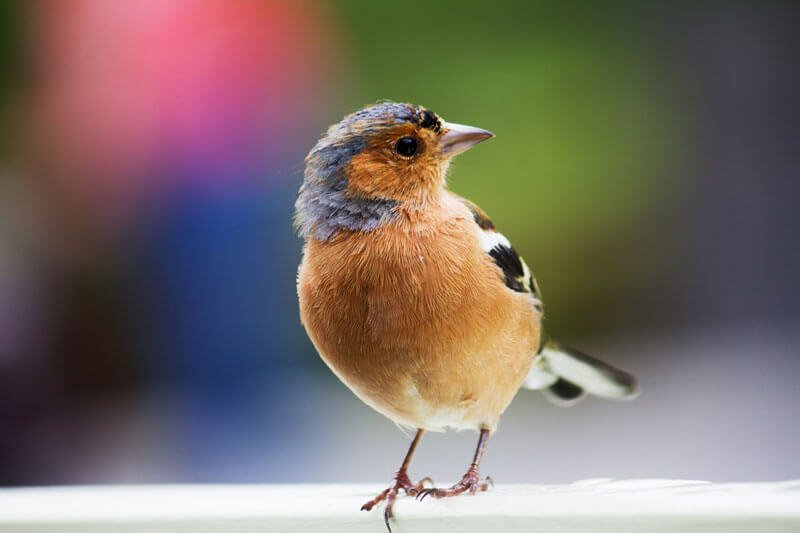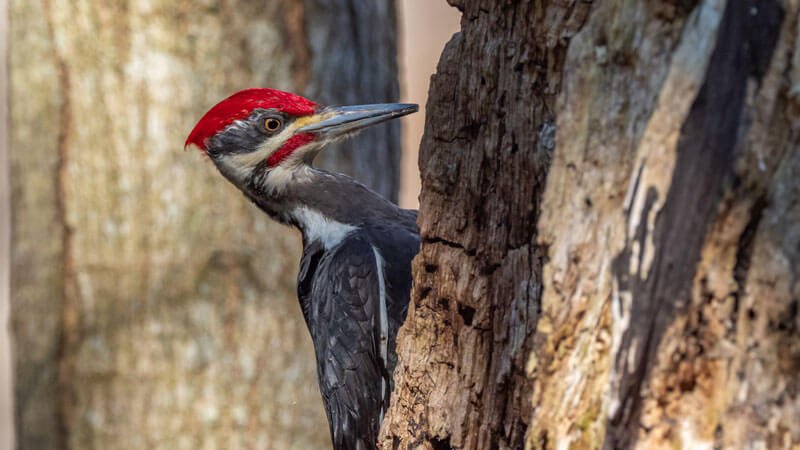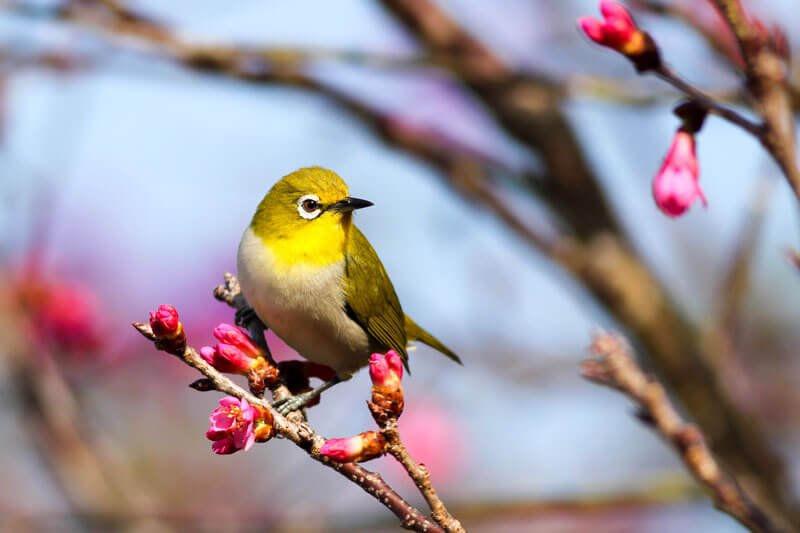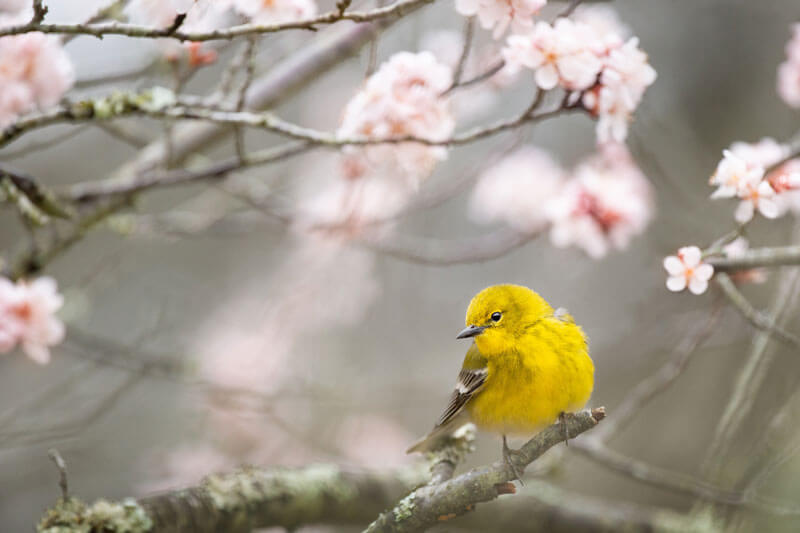The sun slowly peeks over the mountaintops outside your cabin. A soft ray of sunlight slips through the curtains and graces its way across your face. The chirp of morning birdsong floats through your window and draws you peacefully from sleep to wakefulness. You lie there, taking it all in, grateful that you don’t have anything on the schedule – just the freedom of the great outdoors. What a way to start the day!
Whether you’re a passionate birder, an avid photographer, or you’re just looking for a new way to immerse yourself in nature, birdwatching – or “birding” as enthusiasts call it – is a unique experience in the Smokies. With over 200 species of feathered residents living inside the borders of the Great Smoky Mountains National Park, there are plenty of opportunities to explore!
What Makes the Smoky Mountains a Birdwatcher’s Paradise?

The Great Smoky Mountains National Park is a bucket list destination for birdwatchers. The highest crest in the Smokies towers almost a mile above the foothills, and this range of elevation creates a wide variety of climates and terrain. From looming, exposed peaks to sheltered lowlands, you’ll discover a diverse selection of nesting grounds and habitats for a rich variety of bird species. The combination of microclimates, natural beauty, and birds are some of the most varied in the world.
You have your permanent residents – about 60 species who live in the park year-round. Nearly 120 species come for the summer to breed, and even more winter residents use the park as a stopover and foraging area as they migrate further south. No matter what time of year you visit, though, you can find multiple species, even if you’re only there for a weekend. But there are some areas where it’s easier to spy the birds than others.
Top Birdwatching Spots in the Smoky Mountains

With the dense, tall forests in the Smokies, you’re much more likely to hear more birds than you see. But even if you aren’t a birdsong expert, just follow the tweets and chirps, and you can find these amazing fine-feathered creatures. Here are some of the top spots in the Great Smoky Mountains National Park that birdwatchers love.
Cades Cove
Cades Cove is a favorite spot for everyone who visits the park. Its picturesque meadows surrounded by forested tree lines with gorgeous mountains rising in the background make for an idyllic scene. The lower elevation and milder climates create an environment that welcomes several species of birds. And the easily drivable loop road that curves around wide-open fields, tall grasslands, and woodland edges makes it easy for birdwatchers to spot a wide variety of species.
You may see wild turkey roaming about, pileated woodpeckers digging through bark for insects, or great blue herons wading in riverbeds searching for a delicious fish lunch. Keep an eye – and an ear – out for an orchard oriole, a blue grosbeak ruffed grouse, a yellow-throated warbler, a scissor-tailed flycatcher, and so many more. Cades Cove is also home to other wildlife like black bear and white-tailed deer. There’s so much to see. Don’t forget your camera!
Hike to Grotto Falls
Get out of your car and hit the hiking trails to fully immerse yourself in the birdwatching experience. The gentle, 2.6-mile roundtrip hike to Grotto Falls is a favorite among families with younger children. The hike is easy, and the cascading waterfalls are enchanting. The trail is at a slightly higher elevation and boasts a cooler climate with heavily wooded surroundings and a shaded canopy. Birders will be able to spot species like white-throated sparrows and American goldfinch here. Remember to bring your binoculars on this hike so you can peer deep into the trees, while still staying on the designated trail.
Clingmans Dome
Clingmans Dome is one of the most popular birdwatching spots in Great Smoky Mountains National Park. As the tallest point in Tennessee, Clingmans Dome is home to birds who live in higher elevations. The habitat around the Dome is similar to northern boreal forests, so listen out for the trills of the chickadee and the song of the Canada warbler. From the viewing tower, you’ll get breathtaking panoramic views that are well above the treeline, giving you a unique opportunity for catching a glimpse of birds like the red-breasted nuthatch, northern saw-whet owl, dark-eyed junco, wood thrush, and more.
Bird Banding at Tremont
If you’re around in the summer, take advantage of a truly unique birding experience with the Great Smoky Mountains Institute at Tremont. The Institute hosts events known as “bird banding” that give visitors an educational opportunity to learn about bird conservation. Scientists give the public insight into their research monitoring the breeding bird population in Walker Valley. They identify and assess the birds and then attach a band to them so they can track their movement. Sign up for one of their events, and you may even get to hold a live wild bird in your hands!
Gear up for Birdwatching in the Smokies

One of the great things about birdwatching as a hobby is that you don’t need a ton of gear. All you really need are binoculars and maybe a way to document your sightings. The forests in Great Smoky Mountains National Park are thick and lush, so you may have trouble getting a good view of some of the birds. A pair of binoculars will help you see through the trees while still safely protecting the local flora and fauna on your wooded hikes.
The Birds of the Smoky Mountains Checklist is a great guide to use along the way. There are also plenty of apps available to help you look up different species before, during, or after your birdwatching adventure. Some apps even include the specific birdsongs and calls. Learning their signature sounds can help you track them.
Birdwatching in the Smoky Mountains is an incredible way to experience nature, but it’s also an excellent learning opportunity for adventurers of all ages. Get outdoors and explore the Great Smoky Mountains National Park in a new and exciting way!




